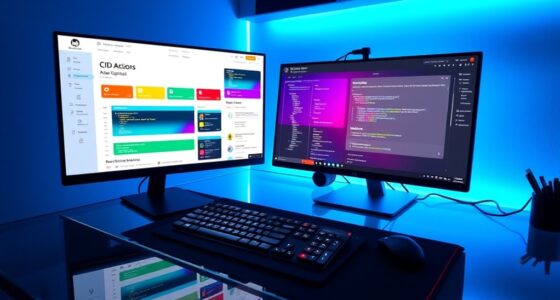DevSecOps Maturity Models help you assess and improve your security practices within the DevOps lifecycle. They provide a structured framework to identify gaps, automate security checks, and embed compliance into your development workflows. As you progress through levels—from manual reviews to automated, continuous security—you’ll enhance your organization’s resilience and agility. Keep exploring to discover how adopting these models can transform your security maturity and support rapid, secure software delivery.
Key Takeaways
- DevSecOps maturity models provide a structured framework to evaluate and enhance security practices within DevOps workflows.
- They guide organizations from manual security efforts to automated, integrated security and compliance processes.
- Maturity levels track progress from isolated security checks to continuous, real-time monitoring and automated incident response.
- Implementing these models improves security automation, reduces human error, and accelerates secure software delivery.
- They foster a security-aware culture by embedding compliance and security measures into daily development activities.

Understanding how your organization approaches security within the DevOps process is essential, and this is where DevSecOps maturity models come into play. These models help you assess your current security practices and identify areas for improvement by providing a structured framework. One of the key aspects of advancing through these levels is adopting security automation. Automation allows you to embed security checks directly into your CI/CD pipelines, reducing manual intervention and minimizing human error. When security is automated, you can quickly detect vulnerabilities, enforce policies consistently, and accelerate your development cycles without compromising security standards.
Embracing security automation in DevSecOps streamlines compliance, reduces human error, and accelerates secure development cycles.
Furthermore, maturity models emphasize the importance of compliance integration. As you progress, you’ll find that integrating compliance checks into your development workflows ensures you meet industry regulations and internal policies without slowing down delivery. This integration isn’t just about passing audits; it’s about embedding compliance into your daily operations so that security and governance become continuous, automated processes rather than afterthoughts. By doing so, you create a culture where security is everyone’s responsibility, and compliance becomes a natural part of development, not a burdensome task.
As you move along the maturity levels, you’ll notice that early stages often involve manual security reviews and isolated compliance efforts. These are good starting points but can lead to bottlenecks and inconsistent enforcement. Progressing through the models involves automating security tests and embedding them into your pipelines, making security checks a routine part of every build and deployment. This shift not only speeds up your releases but also ensures that security issues are caught early, reducing costly fixes later in the development lifecycle.
In mature stages, security automation is deeply integrated, with real-time monitoring, automated incident response, and continuous compliance assurance. At this level, your organization proactively manages security risks with minimal manual oversight. You’ll see security and compliance become continuous, integrated processes that support rapid innovation while maintaining trustworthiness. Additionally, adopting security automation practices can significantly improve your organization’s ability to respond swiftly to emerging threats. The key takeaway is that these models guide you from reactive security measures to proactive, automated security practices that are seamlessly embedded into your DevOps culture. As you advance, your organization becomes more resilient, agile, and capable of meeting the evolving security landscape efficiently and effectively.
Frequently Asked Questions
How Do Organizations Measure Devsecops Success?
You measure DevSecOps success by tracking automation metrics and compliance benchmarks. Automation metrics show how well your team integrates security into development and how quickly you deploy updates. Compliance benchmarks ensure you meet industry standards and regulations consistently. By regularly reviewing these metrics, you can identify areas for improvement and demonstrate progress, helping your organization stay secure, agile, and aligned with security best practices.
What Tools Are Essential for Devsecops Maturity?
You need security automation tools like static application security testing (SAST) and dynamic application security testing (DAST) to integrate security seamlessly into your development process. Use compliance metrics tracking tools to monitor adherence to standards. Continuous integration and continuous delivery (CI/CD) pipelines, along with vulnerability management platforms, help you automate security checks. These tools enable you to improve security posture, streamline workflows, and achieve DevSecOps maturity efficiently.
How Does Culture Influence Devsecops Implementation?
Your organizational mindset and collaboration strategies greatly influence DevSecOps implementation. When your team embraces a security-first attitude and values open communication, you foster a culture of shared responsibility. This encourages seamless integration of security practices into development and operations. By promoting trust and continuous learning, you guarantee everyone stays aligned, making your DevSecOps efforts more effective and sustainable. A positive culture accelerates progress and reduces resistance to change.
Can Small Companies Effectively Adopt Devsecops?
Yes, small companies can effectively adopt DevSecOps by focusing on security integration and team collaboration. You should start with simple, automated security checks integrated into your development pipeline, making security a shared responsibility. Encouraging open communication and teamwork helps break down silos, ensuring everyone understands security practices. With a flexible approach and commitment, even small teams can successfully implement DevSecOps to improve security and accelerate delivery.
What Are Common Challenges in Advancing Devsecops Maturity?
You’ll face challenges like integrating security seamlessly into your workflows and advancing process automation. As you push for higher maturity, security integration often stalls due to legacy systems or resistance to change. Meanwhile, automating security tasks can be complex, risking gaps if not done carefully. Staying alert and adaptable is key—overcoming these hurdles demands continuous effort and strategic planning to truly elevate your DevSecOps maturity.
Conclusion
By embracing DevSecOps maturity models, you can considerably reduce security risks and boost efficiency. Did you know that organizations adopting mature DevSecOps practices report a 50% faster deployment rate? This shows that integrating security early not only protects your infrastructure but also accelerates innovation. So, take the step toward maturity today—your team and users will thank you for the safer, quicker, and more reliable software delivery.








